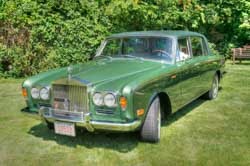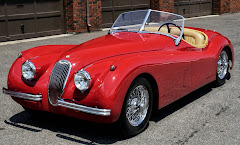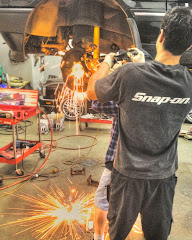At this year’s national meet of Rolls-Royce and Bentley
owners I saw the collision of modern day repair practices and the standards judges
apply on the show field. It’s worth
thinking about this because similar situations can be found in any car line and
they will only become more common with time.
The problem is becoming more acute thanks to technological
shifts in the car industry. Fifty years
ago, cars were mechanical things with simple electrical systems to provide
lights, ventilation fans, and other essentials.
Today’s cars are collections of computers tied together with data buses
controlling the electro-mechanical subassemblies that move us, stop us, and
keep us entertained and comfortable.
As automotive technology evolves the car manufacturers are
left with less and less ability to support vintage models. Yet the vintage cars are important because
they are a part of brand identity, and often owned by affluent enthusiasts who
buy new cars and influence other enthusiasts.
What happens when the professionals who keep our vintage
cars on the road run up against the desires of others in the field to “preserve
them the way they were built?” In one of
the 2016 RROC meet’s technical sessions I listened to Mr. John Palma talk about
fixes he had developed to keep our cars on the road. For some the factory had
abandoned support for low demand parts. He
found new solutions when “proper” parts remain available but the costs don’t
make sense for most owners. Finally he
described original parts that were deficient, and he has devised a better
widget for those cases.
Mr. Palma is one of our Club’s most esteemed technical
consultants. He’s spent much of his life practicing the craft of Rolls-Royce
and Bentley service, and his work is widely admired and respected. Yet I was troubled by the idea that
innovations like he presented might be divisive on the show field even as they
are obvious functional improvements. For
example, he talked about a gear reduction starter they had devised to address
the perennial cranking difficulties experienced by some cars. That starter has become the go-to part when
someone needs a RR/B starter, and good strong operation is their #1 criteria.
That said, it looks quite different from the original
starter. You might say the Palma starter
is made for superior function, not correctness of style. If you want style, there are shops that can
rebuild your old RR/B starter and make it as good as it can be. They can also make it look 100% correct, even
if the best it can do technically is only 70% of what Mr. Palma’s unit does.
Clearly Mr. Palma’s starter is a hit with those who want
reliable starting. What about the people
who show their cars? And more important,
what about the people who judge the show cars?
The RROC has all the judging sheets and guides on the
website. The judges are available to answer questions. In fact, the acceptability of an improved
starter was even raised on the club forum a few weeks before the meet. The consensus was that the club has two
classes of show cars, and they should treat issues like this differently.
Touring cars are those cars that are actually driven by their owners. On a touring car, sensible functional
modifications like a Palma starter should be acceptable. Whether they actually are acceptable is
another matter, and varies from club to
club and even judge to judge.
Then we have the second class of show car. Pure concours
cars are not restored to be driven. They
are prepared to match as closely as possible the new vehicle as it left the
dealership however many years ago. A
starter upgrade that was developed 50 years after a car was manufactured is not
acceptable in a concours car.
This dichotomy shows the direction cars clubs must evolve
toward. On the one hand, they want to
support people who actually want to drive and enjoy old cars. Some of those people will limit themselves to
maintenance and improvements like the Palma starter. Others will want to add modern conveniences,
like air conditioning, Bluetooth music streaming, or navigation. How do welcome those folks to the show
field? Do we say the touring group
encompasses all such variations? What
then are the judging standards? Should any modification be ok, as long as it's tastefully done, and we limit our judging to workmanship?
We can't forget the people who want to preserve old cars in
their original form, to the extent possible.
Some of those people see vintage cars as works of art, to be admired but
not driven. Other preservationists want
the cars to look original, but they embrace the inclusion of modern technology
as long as it’s invisible. I can understand where they are coming from too.
Most concours judging sheets focus on what you can see
without disassembly. That means a better
starter would be ok, as long as it’s in the original case, or hidden from view. The engine could be rebuilt with improved
modern internals, as long as the exterior looked unchanged. The strict preservationists and the internal
modification group can co exist, as long as their cars look stock and original.
There's also a question as to what constitutes "original." Take the caps on the tire valves as one small example. Many dealerships have accessory departments with ten or even twenty different caps. Are we to mark down a car for "non original caps" when the original buyer made such an accessory choice? Some judges say "it's ok if the owner can show the accessory was fitted at the dealer when delivered." But what sense does that make, to allow a dealer-fitted cap while rejecting the same cap purchased from a catalog six months later.
There's also a question as to what constitutes "original." Take the caps on the tire valves as one small example. Many dealerships have accessory departments with ten or even twenty different caps. Are we to mark down a car for "non original caps" when the original buyer made such an accessory choice? Some judges say "it's ok if the owner can show the accessory was fitted at the dealer when delivered." But what sense does that make, to allow a dealer-fitted cap while rejecting the same cap purchased from a catalog six months later.
What do the people want?
That is a good question. Older
club members (in my experience) tend to favor originality and focus on
details. Younger club members often focus
on function – which is usually improved with new technology – and they want to
have fun with their cars more than just looking at them.
We talk about the need to bring younger people into our car
clubs. Are our show standards standing
in our way? Might we change them to
attract younger members?
I don’t propose an answer so much as raise the question.
(c) 2016 John Elder Robison
John Elder Robison is the general manager of J E Robison Service Company, celebrating 30 years of independent Land Rover, Rolls-Royce and Bentley restoration and repair in Springfield, Massachusetts. John is a longtime technical consultant to the Land Rover, Rolls-Royce and Bentley clubs, and he’s owned and restored many fine British motorcars. Find him online at www.robisonservice.com or in the real world at 413-785-1665
Reading this article will make you smarter, especially when it comes to car stuff. So it's good for you. But don't take that too far - printing and eating it will probably make you sick.



























3 comments:
There is a story, possibly true, that when faced with 2 perfect classic cars a judge put on a white glove. The car that had the cleanest tailpipe INSIDE the pipe, won. To me this is silly. In the UK they still RACE blower Bentleys.
I am one of those horrible, awful people who would put a 5 speed and improved cooling in an E-type and DRIVE it.
Nuff said.
Emcee, I think people who feel as you do are a significant part of the old car enthusiast population. And we should support the group.
I agree recent cars are made so complicated that it takes longer to fix the breakdowns of them. So how do you cope with the complication? Do you ask other mechanics specializing in car electronics to deal with the problems, or do you solve them on your own, Mr. Robison?
Post a Comment